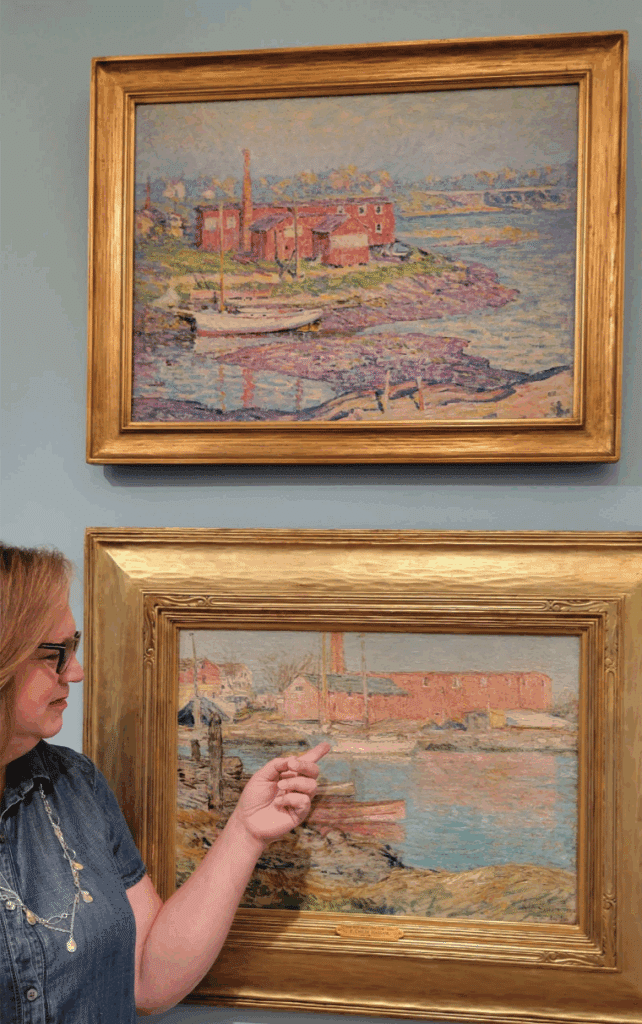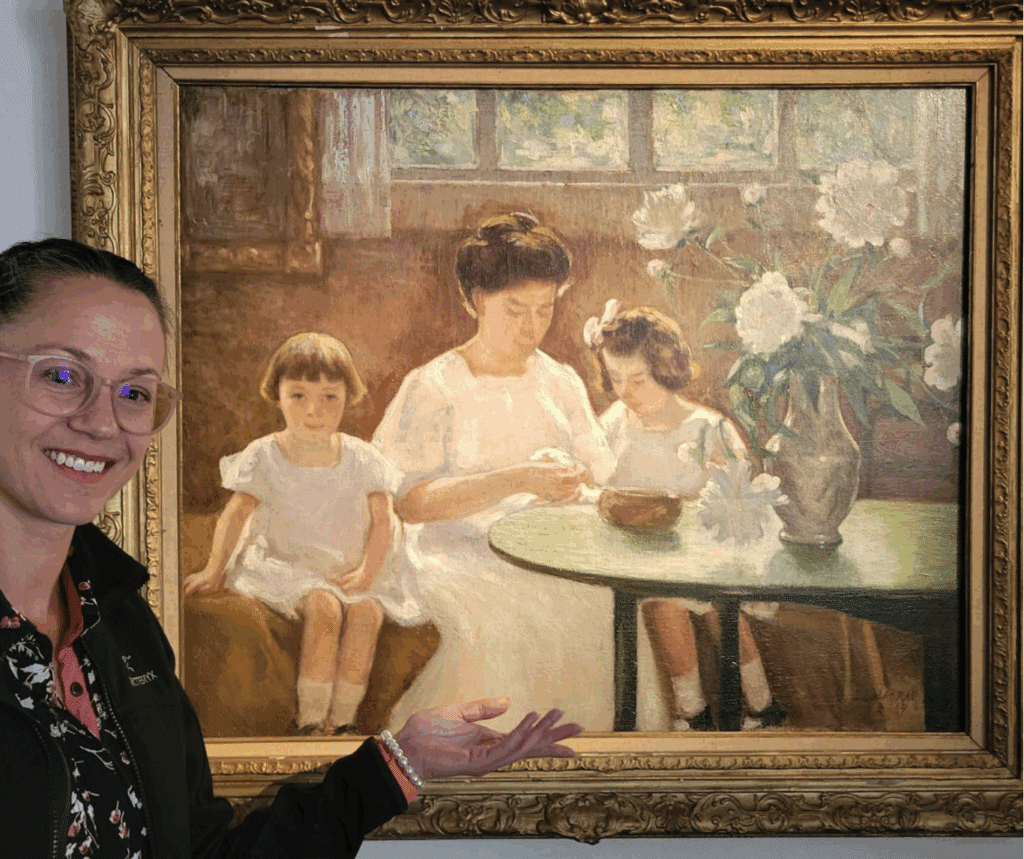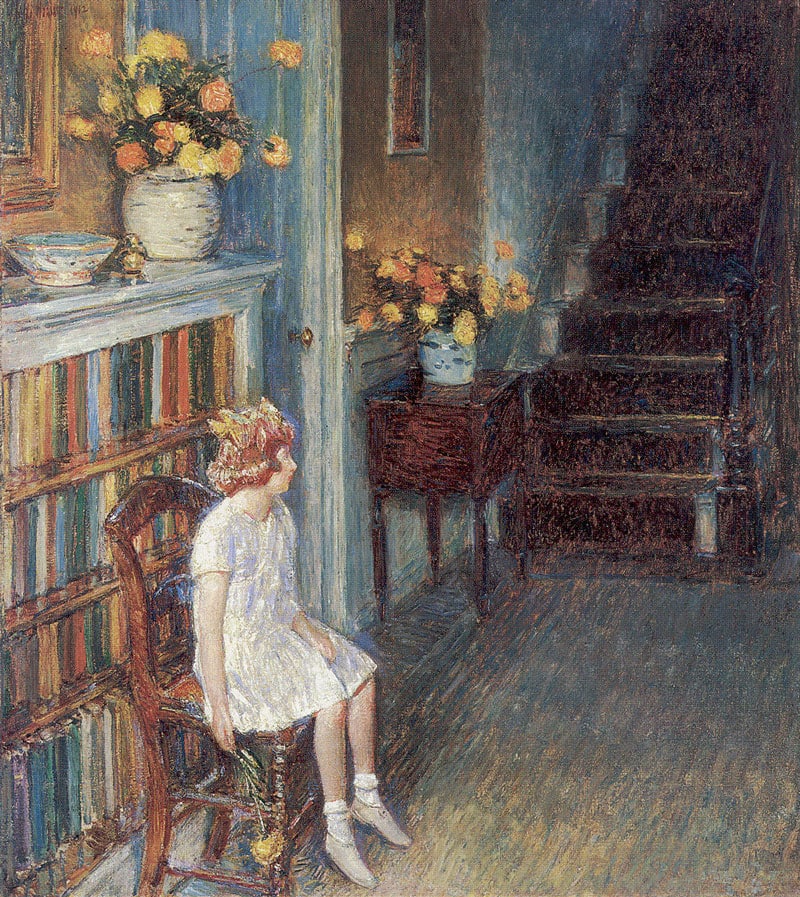By Laura McCormick | Greenwich Sentinel | October 10, 2025
National Historic Landmark Bush-Holley House takes center stage in the Historical Society’s new exhibition that was unveiled this week. The Holley Boarding House: Inspiring American Impressionism (October 8 – March 8, 2026) artfully demonstrates how entrepreneurial women in the late 19th century, emboldened by new opportunities in post- Revolutionary war America, enabled Holley House to become the setting for the Cos Cob art colony, the first Impressionist community in Connecticut, and among the earliest in the nation.
The Centennial celebration of the Declaration of Independence in 1876 reignited national interest in the ideals of the Revolution and ushered in a new era of opportunity for women. The Holley House proprietors seized on this new development to expand upon their domestic roles as boarding house owners and become influential businesswomen who attracted the founders of American Impressionism.
This exhibition is the second in a three-part series that kicked off in fall 2024 to explore the impact of the American Revolution in Greenwich. The third exhibition follows in April 2026.
Holley House: A Beacon for NYC Artists

The most famous chapter in the history of Bush-Holley House was from the early 1890s until the 1920s when the Holley boarding house became a gathering place for talented Impressionist artists and writers.
Frequent boarders included John Henry Twachtman, J. Alden Weir, Childe Hassam and Theodore Robinson who founded the Cos Cob art colony and were instrumental in shaping American Impressionism during the late 19th and early 20th centuries. Their works are featured in the Greenwich Historical Society and many prominent museums throughout the country.
The picturesque setting on the banks of the Mianus River and the familial and nurturing home environment created by boarding house proprietors Josephine Holley and her daughter Constant Holley MacRae ignited the creativity of the artists. It was a respite from their New York City dwellings, especially in summer months.
“My intention is to show how Josephine Holley and Constant Holley MacRae took full advantage of their historic home and neighborhood with an active riverfront to make it appealing to a diverse group of exceptionally talented artists and writers,” says exhibition curator Kathy Craughwell- Varda. “This previously unexplored angle will enable visitors to learn how the artists lived there and were inspired to create some of the most important pieces of American Impressionist art.”
The boarding house was a labor of love for the Holley women, and a tremendous asset for the visiting artists. Its location near the railroad offered convenient transportation from NYC and the combination of water, sunlight, rural countryside and a defunct shipyard suited the artists’ work.
They were a tight-knit collegial group with a deep passion for the arts. While they often painted the same outdoor scenes, they brought. different perspectives to their canvases and even critiqued each other’s works. They also exchanged ideas with visiting writers, political commentators, essayists and humorists.
And they always had fun when not painting due to Constant’s creativity and commitment to making the house enjoyable for boarders. She created event s f rom everyday activities such as apple picking and even made chopping down trees an enjoyable pastime. Charades were frequently performed on the front porch which everyone loved.
Important canvases will be featured by many of the art colony members. Among the most prized in the collection is Childe Hassam’s Clarissa which he painted of Constant and Elmer Livingston MacRae’s daughter while she sat in the front hall of Holley House. Hassam’s masterly attention to detail is evident in her subtle facial expression, seemingly lost in her thoughts.
Paintings by other acclaimed art colony Impressionists that are in the exhibition include Mathilda Browne, renowned for her floral and farm scenes, Japanese-born Genjiro Yeto, who introduced the art colonists to Japanism, and Henry Fitch Taylor who successfully migrated to modernism.
Also on display will be art colony letters and memorabilia, and an autographed copy of a novel by Willa Cather. The masterful writer whose stories focused on the American experience was a frequent guest at Holley House, attracted to it for the same reasons that drew the Impressionists.
Immersive experiences provide hands-on interaction
Visitors can take on the role of the students who were taught at the art colony by the Impressionists and hang their own art exhibition by selecting from reproductions of their paintings. They can explore the Lower Landing on the banks of the Mianus River where the artists found inspirational settings for their works and compare photos and paintings of the same locations.
“We want to create an immersive experience for visitors so they can appreciate how the art colony artists were inspired to create many of their artworks,” says Craughwell- Varda. “They will learn about the artists’ styles and be able to view them critically without criticism.”
Rediscovering the Cos Cob Art Colony: A Tribute to Susan G. Larkin
In this separate, complementary exhibition in the Historical Society’s Permanent Collections Gallery is a selection of prized works from the private collection of Susan G. Larkin. Author of the definitive book on the art colony “The Cos Cob Art Colony: Artists on the Connecticut Shore”
Dr. Larkin is credited for bringing attention to the Impressionists who gathered at Holley House.
“Bush-Holley House is important for seeing where these artists lived and painted for experiencing a sense of place,” she wrote. “Cos Cob in the 1890s was as important to them as Argenteuil in the 1870s had been to Monet, Renoir and Manet.”
“Susan Larkin’s lifelong quest to uncover the artists and artworks of the Cos Cob art colony has been instrumental in restoring it to its rightful place as one of the most important American art colonies,” says Historical Society Executive Director and CEO Carol Cadou. “The Historical Society is indebted to Susan for her generosity and years of service teaching and engaging on the art colony.”
Dr. Larkin’s collection, which includes etchings, paintings, watercolors and sculpture, reflects the diversity of the Cos Cob art colony. Kathy Craughwell-Varda weaves into the texts personal notes from Dr. Larkin’s papers and manuscripts to provide greater depth and context into the Impressionists’ works.
The exhibit ion and its catalogue are generously supported by Josie Merck.
Special programs for adults and children

Lectures, hands-on programs and tours will be offered throughout the exhibition. Museum docents will explore stories that delve into how the Holley women created a haven and place of inspiration for visiting artists and writers.
On October 19th, master Impressionist Dmitri Wright will host an outdoor painting workshop inspired by the Impressionists who were influenced by Holley House and its surroundings. Participants will step into the world of the art colony and engage in the plein air style of the artists through the creation of their own art works. For more information and to register: Echoes of Impressionism: Paining in the Footsteps of the Cos Cob Masters.

